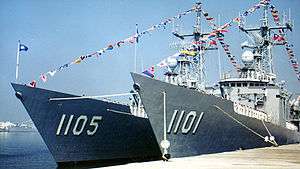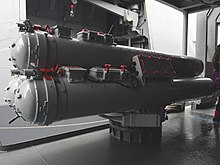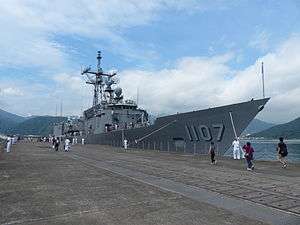Cheng Kung-class frigate
The Cheng Kung-class frigates are guided-missile frigates (PFG) currently in service of the Republic of China (Taiwan) Navy (ROCN). They are based upon the U.S. Oliver Hazard Perry class and built by China Shipbuilding Corporation in Kaohsiung, Taiwan under license throughout the 1990s as parts of the "Kuang Hua One" patrol frigate, guided project. These frigates served as the mainstay of the ROCN's theater air defense prior to the ROCN's acquisition of Keelung (Kidd)-class destroyers in 2005.
 ROCS Cheng Kung (1101) and ROCS Chi Kuang (1105) | |
| Class overview | |
|---|---|
| Name: | Cheng Kung class |
| Builders: | China Shipbuilding Corporation |
| Operators: |
|
| In commission: | 1993–present |
| Completed: | 8 |
| Active: | 8 |
| General characteristics | |
| Type: | Frigate |
| Displacement: | 4,103 long tons (4,169 t) full load |
| Length: | 453 ft (138 m) |
| Beam: | 46.95 ft (14.31 m) |
| Propulsion: | 2 × General Electric LM2500-30 gas turbines, 41,000 shp (31 MW); 2 × Auxiliary Propulsion Units, 350 hp (.25 MW) |
| Speed: | over 29 knots (54 km/h) |
| Complement: | 235 |
| Sensors and processing systems: |
|
| Electronic warfare & decoys: |
|
| Armament: |
|
| Aircraft carried: | 2 × S-70C(M)-1/2 |
Design
In order to control the new weapon systems on the frigates, which Mk 92 could not integrate at the time, a second CDS, H930 MCS was installed in order to control the 8 HF-2 (or four HF-2 and four HF-3 on certain ships) and the two Bofors 40mm/L70 guns. However, the Mk 92's Harpoon mode was deleted due to the US government refusal to sell the Harpoon missile system to Taiwan at the time. Also deleted were some of Mk 92's ASW modes, along with the refusal to sell SQR-19 Towed Array sonar system.
Originally only two lead ships were going to be built to this standard, the rest of the six ships in the class were going to be built under ACS (Advance Combat System) project with a lighter AEGIS (that later became SPY-1F), 48-64 cell Mark 41 Vertical Launch System and other systems, and a 15 metres (49 ft) plug-in section. Delay in the design and budget changed the project to four ships in PFG-1101 configuration and the last four ships in ACS configuration, then more delays changed to 6+2, then 7+1. By the mid 1990s, the ROCN decided the ACS project was too risky, too long and too over budget, finally canceling it after the seventh ship was built to the PFG-1101 standard. However, enough of the long lead items were already purchased so that in late 2000, the ROCN decided to go ahead with the eighth ship's construction with PFG-1101 configuration—minus the two Bofors 40mm/L70 guns, after getting necessary funding.
Upgrades

_20170309.jpg)

The Cheng Kung class was initially fitted with 8 × Hsiung Feng II ship-to-ship missiles, instead of the Harpoon missiles that the Oliver Hazard Perry class used. In 2001, ROCS Cheng Kung (成功, PFG-1101) was refitted with four Hsiung Feng III missiles, replacing four of the Hsiung Feng II missiles. In 2009 ROCS Chi Kuang (繼光, PFG-1105) was seen with same configuration. All the other ships in the class received the new missile upon their major overhaul.
Originally, all HF-2 missiles were to be removed, while 4-8 Harpoon were to be carried in the Mk 13 launcher's magazine (with the necessary upgrade to the ship's Mk 92 CDS which had a Harpoon control mode and functionality deleted when ship was built), and 8 HF-3 supersonic AShM to put in place of 8 HF-2 AShM, giving these ships a total of 12-16 anti-ship missiles. But the Legislative Yuan refused to release funding for the CDS upgrade, and the ROCN had to settle for just 4 HF-2 and 4 HF-3 configuration. All ships had the Link 16 datalink installed.
Seven out of eight ships added Bofors 40 mm/L70 guns for both surface and anti-air use.
In 2014, the Republic of China Navy revealed plan to develop a naval air defense missile system derived from the land-based Sky Bow system. The Cheng Kung-class frigates are speculated to be one of the potential platforms to carry the system.
On November 5, 2012 Taiwan announced the U.S. government would sell Taiwan two additional Perry-class frigates that are about to be retired from the U.S. Navy for a cost of US$240 million to be retrofitted and delivered in 2015. Naval Vessel Transfer Act of 2013 was signed by President Obama in 2014, allowing up to four of the frigates to be sold to Taiwan. Two ships were eventually selected and were reactivated by VSE Corporation and transferred to Taiwan on 9 March 2017.[1] These ships would replace aging Chiyang class (US ex-Knox-class frigate) vessels that joined the ROC Navy more than 20 years ago.
After the US stopped supporting the SM-1 and their associated launch system support was taken up by NCSIST which also implemented an upgrade program for the missiles. Upgrades to the SM-1 include a better rocket motor and an active seeker.[2]
Ships
The Cheng Kung-class frigates are named after historical Chinese generals who were famous for defeating foreign threats.
| Ships in class | |||||
|---|---|---|---|---|---|
| Name | Laid down | Launched | Commissioned | Home port | Status |
| ROCS Cheng Kung (成功, PFG2-1101) | December 21, 1990 | October 5, 1991 | May 7, 1993 | Pescadores | Active |
| ROCS Cheng Ho (鄭和, PFG2-1103) | October 29, 1991 | October 15, 1992 | March 28, 1994 | Pescadores | Active |
| ROCS Chi Kuang (繼光, PFG2-1105) | October 30, 1992 | October 3, 1993 | March 4, 1995 | Pescadores | Active |
| ROCS Yueh Fei (岳飛, PFG2-1106) | September 5, 1993 | August 28, 1994 | February 26, 1996 | Pescadores | Active |
| ROCS Tzu I (子儀, PFG2-1107) | August 7, 1994 | July 13, 1995 | January 9, 1997 | Pescadores | Active |
| ROCS Pan Chao (班超, PFG2-1108) | July 25, 1995 | July 3, 1997 | December 16, 1997 | Pescadores | Active |
| ROCS Chang Chien (張騫, PFG2-1109) | December 4, 1995 | May 14, 1997 | December 1, 1998 | Pescadores | Active |
| ROCS Tian Dan (田單, PFG2-1110) | February 22, 2001 | October 17, 2002 | March 11, 2004 | Pescadores | Active |
| ROCS Ming-chuan (銘傳, PFG-1112) | ex-USS Taylor | November 8, 2018 | Active | ||
| ROCS Feng Jia (逢甲, PFG-1115) | ex-USS Gary | November 8, 2018 | Active | ||
See also
- F100-class frigate
- FREMM multipurpose frigate
- La Fayette-class frigate
- Type 054A frigate
- Chiayi-class patrol vessel
- Yilan-class patrol vessel
References
- "Taiwan receives two US Navy frigates". 8 August 2017.
- Lundquist, Edward H. "Interview with Adm. Richard Chen, Republic of China Navy (Ret.)". www.defensemedianetwork.com. Defense Media Network. Retrieved 12 July 2020.
External links
| Wikimedia Commons has media related to Cheng Kung class frigates. |
- PFG-2 Cheng Kung-class (Perry) Frigate - Globalsecurity
- Taiwan seeking Aegis destroyers from U.S.: report - Reuters
